The Modern Stunt Pattern
The modern stunt pattern consists of a series of fifteen
maneuvers with a specified order in which they are to be flown. In the US system of scoring, each maneuver that is attempted is given a score of from 10 to 40 points by a minimum of two judges who are sitting outside the flight circle. Under the US scoring system there is no "k factor"
as under FAI rules where the scores are then multiplied by a number according to the difficulty of the maneuver before the scores are totaled. Thus an easy maneuver, flown well, will score equally as high as a more difficult maneuver also flown well.
The various maneuvers of the modern pattern are listed in the list that follows, and a more detailed description taken from the
US rule book is shown below with illustrations. Simply scroll down through the pattern as a whole or click on each maneuver or procedure listed in the STUNT PATTERN LIST to move directly to its description. Thank you to Stuka Stunt Works from which I borrowed liberally.
STUNT PATTERN LIST
Appearance Points 0-20 points
Flight Procedures/Starting no points
Takeoff and level flight 10-40 points
Reverse wing-over 10-40 points
Three inside loops 10-40 points
Inverted laps (2 laps) 10-40 points
Three outside loops 10-40 points
Two inside square loops 10-40 points
Two outside square loops 10-40 points
Two inside triangular loops 10-40 points
Two horizontal eights 10-40 points
Two square horizontal eights 10-40 points
Two vertical eights 10-40 points
Hourglass 10-40 points
Two overhead figure eights 10-40 points
Four-leaf clover 10-40 points
Landing 10-40 points
Flight Pattern 25 points
Final Thoughts and Observations
Appearance:
Models shall be judged for appearance complete and ready
to fly. After model has been judged, nothing will be removed or added to
the model which, in the judges' opinion, changes in any manner the appearance
of the model from the way it was when presented for appearance judging.
However, during any attempt for official flight after the contestant has
begun to crank the engine, if it becomes necessary to remove the propeller
spinner for changing of propeller, etc., then it is permissible to leave
off the spinner for that particular flight. Any damage to the model after
judging, or changes that may be made as a result of such damage, will not
be cause for loss of appearance points. Appearance judging will take place
just before contestant's first flight. (At the Nats, due to the large number
of entries, the appearance judging takes place during the pilots' meeting
on the day before the first day of qualifying.) Judges shall exercise prudence
in assigning points, and reserve excellent point values for those models
which are decidedly above average.
Return to STUNT PATTERN LIST
Flight Procedures/Starting:
Each contestant will be called to the circle when it is
his or her turn to fly. From the time they are called to the circle, contestants
will have a maximum of five minutes to give the hand signal to begin starting
their engine(s). Once the starting hand signal has been given, contestants
will be allowed a maximum of three minutes to become airborne. A contestant
may make as many starts as necessary, or may take off, land and restart
if necessary, as long as the three minute time period has not been exceeded.
If a second takeoff is made during the three minute time period, the first
takeoff score will be canceled and a new score given. NOTE: Bonus
points for starting within one minute and the requirement that the engine
be hand started have been dropped under the US rules. Furthermore: Eight
minutes total elapsed time (rather than 7 under FAI rules) is allowed from
the time the contestant gives a hand signal prior to starting his engine
to start, take off, complete the flight pattern, and land.
ATTEMPTS:
Failure to give the starting hand signal within five minutes
of being called to the circle, or failure to become airborne within three
minutes of giving the starting signal, shall be charged as an attempt.
Contestants shall be allowed three attempts to make two official flights.
No maneuver, including the landing, will be scored after the eight minutes
allowed have elapsed.
Return to STUNT PATTERN LIST
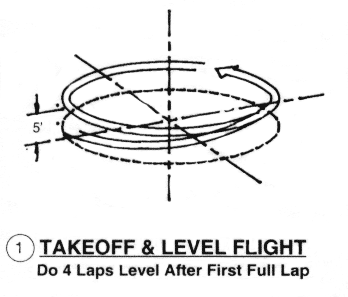 Takeoff and level flight: Takeoff and level flight:
A correct takeoff consists of the model rolling smoothly
along the ground for a distance of not less than 4.5 meters (14.8 feet)
but not greater than one-quarter of a lap. The model then rises smoothly
into the air with a gradual climb and a smooth leveloff to normal flight
level (approximately 5 feet) over the point at which the model began its
ground roll. The model continues on for two smooth laps of normal level
flight to the point of original leveloff.
Errors:
The model bounces, or becomes airborne too soon or too late.
Takeoff, climb, or leveloff is not gradual and smooth. Leveloff occurs
too soon, or too late. Leveloff and normal flight level are not within
a height of 1.2-1.8 meters (3.9-5.9 feet).
Return to STUNT PATTERN LIST
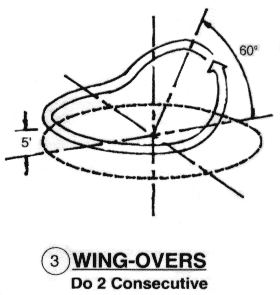 Reverse Wingovers (one required): Reverse Wingovers (one required):
Correct reverse wingovers are judged when the model starts
from normal flight level, makes a vertical climb and dive, passing directly
over the flyer's head, cutting the ground circle in half, and recovers
in an inverted position at normal flight level. The model then continues
for half a lap inverted to the starting point, and again makes a vertical
climb and dive over the center of the circle from inverted flight, before
recovering upright at normal flight level.
Errors:
First half: the model starts at other than normal flight level,
wobbles when going into climb, or turn exceeds 2.1 meters (6.9 feet) radius.
The model does not cross directly over flyer's head. The model does not
cross the circle in a straight line. the model wobbles or recovers at other
than normal flight in an inverted position or turn exceeds 2.1 meters (6.9
feet) radius. the model does not cut the circle in the same position and
direction in second part of maneuver.
Second Half: Scored same as first half, reversing the entry and
recovery positions.
Return to STUNT PATTERN LIST
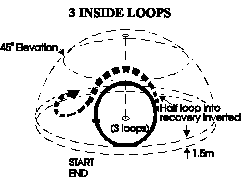 Consecutive
Inside Loops (Three Required): Consecutive
Inside Loops (Three Required):
Correct loops are judged when the model starts from normal
flight level and makes a series of three smooth, round loops, all in the
same place with the bottoms of the loops at normal flight level and the
tops of the loops with the lines at 45 degrees elevation. The model then
continues for another half loop, recovering inverted and descending to
normal flight level, flying two laps before being judged for inverted flight.
Errors:
Loops are rough and irregular (i.e. egg-shaped, hexagonal, etc.).
Bottoms of loops are not at 1.2-1.8 meters (3.9-5.9 feet) height. Tops
of loops vary more than 0.6 meter (2 feet), plus or minus, of the 45 degrees
elevation point. Second and third loops vary more than 0.6 meter (2 feet)
from the path of the first loop.
Return to STUNT PATTERN LIST
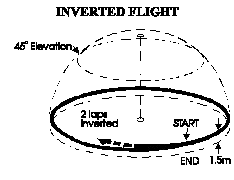 Inverted Flight (two laps): Inverted Flight (two laps):
Correct inverted flight is judged when the model makes two
smooth, stable laps at normal flight level.
Errors:
Height is not 1.2-1.8 meters (3.9-5.9 feet). Height varies more
than 0.6 meter (2 feet).
Return to STUNT PATTERN LIST
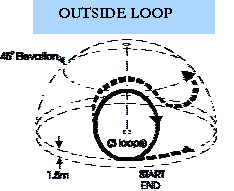 Consecutive Outside Loops
(Three Required): Consecutive Outside Loops
(Three Required):
Correct loops are judged when the model starts from the
inverted position at normal flight level and makes a series of three smooth,
round loops, all in the same place, with the bottoms of the loops at normal
flight level and the tops of the loops with the lines at 45 degrees. The
model then continues for another half loop, recovering at normal flight
level.
Errors:
Loops are rough and irregular (i.e. egg-shaped, hexagonal, etc.).
Bottoms are not at 1.2-1.8 meter (3.9-5.9 feet) height. Tops of loops vary
more than 0.6 meter (2 feet), plus or minus, of the 45 degrees elevation
point. Second and third loops vary more than 0.6 meter (2 feet) from the
path of the first loop.
Return to STUNT PATTERN LIST
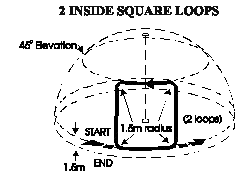 Consecutive Inside Square Loops
(Two Required): Consecutive Inside Square Loops
(Two Required):
Consecutive inside square loops are judged correct when
the model starts from normal flight level and flies a square course consisting
of two loops, each with four inside turns of approximately 1.5 meters (4.9
feet) radius and straight equal sized segments, with bottom segments at
normal flight level and top segments as inverted level flight at 45 degrees
line elevation. The two bottom corners are equal and so are the two top
corners. The maneuver begins and ends with the model in level flight at
the point of start of the first turn.
Errors:
Model wobbles on turns. Lower height is not between 1.2-1.8
meters (3.9-5.9 feet). Upper height is not within 0.6 meter (2 feet) of
the 45 degrees elevation point. Turns are not precise and/or exceed 2.1
meters (6.9 feet) radius. Sides of loops are not equal. Second loop is
not in the same flight path as the first loop.
Return to STUNT PATTERN LIST
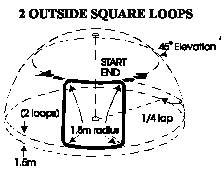 Consecutive
Outside Square Loops (Two Required): Consecutive
Outside Square Loops (Two Required):
Consecutive outside square loops are judged correct when
the model starts from level flight at a 45 degrees elevation and flies
a square course (starting with a vertical dive) consisting of two loops,
each with four outside turns of approximately 1.5 meter (4.9 feet) radius
and straight equal sized segments with bottom segments flown inverted at
normal flight level and top segments as level flight at 45 degrees elevation.
The two bottom corners are equal and so are the two top corners. The maneuver
begins and ends with the model in level flight at the point of start of
the first turn. The model recovers into normal level flight.
Errors:
Model wobbles on turns. Lower height is not within 1.2-1.8 meters
(3.9-5.9 feet). Upper height is not within 0.6 meter (2 feet) of the 45
degree elevation point. Turns are not precise and/or exceed 2.1 meters
(6.9 feet) radius. Sides of loops are not equal. Second loop is not in
the same flight path as the first loop.
Return to STUNT PATTERN LIST
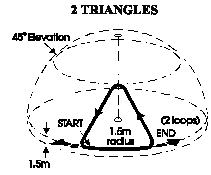 Consecutive
Inside Triangular Loops (Two Required): Consecutive
Inside Triangular Loops (Two Required):
Correct triangular loops are judged when the model starts
from normal level flight and flies a triangular course, starting at the
base turn. The three sides of equal length and the three corner angles
of equal size. The top corner must be placed at 45 degrees elevation. The
second triangular loop must be flown in the same flight path as the first
one. All corners must be smooth, precise, and of approximately 1.5 meters
(4.9 feet) radius.
Errors:
Model starts at a height other than between 1.2-1.8 meters (3.9-5.9
feet). Turns are rough and wobbly or exceed 2.1 meters (6.9 feet) radius.
Peak of second turns is not within 0.6 meter (2 feet) of the 45 degrees
elevation point. Sides are wobbly and/or not equal in length. Second loop
is not in the same flight path of the first loop.
Return to STUNT PATTERN LIST
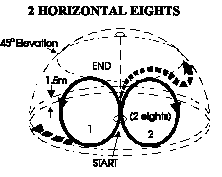 Horizontal
Eights (Two Required): Horizontal
Eights (Two Required):
Horizontal eights are to be entered and completed at the
intersection point of the circles and exit at the same point. The inside
loop must be flown first. Correct eights are judged when the model makes
two eights, each consisting of two round circles or loops of the same size,
tangent to each other, and in a horizontal line. The model must enter the
eight from normal flight level and be vertical at the intersection point
of tangency of the circles. The eights must be symmetrical. At the top
of each circle the model must be at the 45 degree elevation point; the
bottoms of the circles must be at normal flight level.
Errors:
Model is not vertical at entry. Model at the top of circles
is not within 0.6 meter(2 feet) of 45 degrees elevation point. Bottoms
of circles not within 1.2-1.8 meters (3.9-5.9 feet) height. Loops are not
round and equal in size. Point of intersection varies. Second eight is
not in the same position as the first.
Return to STUNT PATTERN LIST
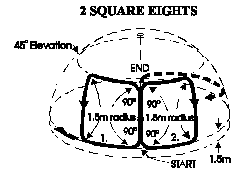 Square Horizontal Eights
(Two Required): Square Horizontal Eights
(Two Required):
The eight is to be entered in the direction of the climbing
sides of the loops, and after completion of two eights the exit is made
in the same direction. The inside loop must be flown first. Correct eights
are judged when the model starts a vertical climb and makes a modified
inside square loop followed by a modified outside square loop ending with
a vertical climb at the same point. The loops are modified so their climbing
sides are vertical, and the loops are tangent to each other along these
sides, and the turns starting and ending the climbs are 90 degrees. The
top sides are slightly shorter than the remaining sides which are of equal
length. The maneuver is repeated to form two eights. Tops of loops must
be at 45 degrees elevation, bottom of loops must be at normal flight level,
and all turns must be smooth, precise and of approximately 1.5 meters (4.9
feet) radius.
Errors:
Corners exceed 2.1 meters (6.9 feet) radius. Sides are not straight.
Vertical sides and bottom sides are not equal in length. Loops are not
equal in size. Top and bottom sides are not horizontal. Turns starting
and ending the climbs are not 90 degrees. Tops of loops are not within
0.6 meters (2 feet) of 45 degrees elevation. Bottom of loops are not within
1.2-1.8 meters (3.9-5.9 feet) in height. The position of the climbing side
varies. Second eight is not in the same position as the first one.
Return to STUNT PATTERN LIST
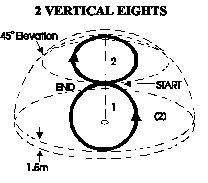 Vertical Eights (Two Required): Vertical Eights (Two Required):
Vertical eights are to be started at the point of 45 degrees
elevation and finished at the same point in inverted flight. The inside
loop must be flown first. Correct eights are judged when the model makes
two eights, each consisting of two round circles or loops of the same size,
tangent to each other, and in a vertical line. The model must be horizontal
at the intersection point of tangency of the circles. The eights must be
symmetrical, the top of the heights at a point 90 degrees over the flyer's
head, and the bottom of the eights at normal flight level.
Errors:
Model is not horizontal at entry. Entry is not within 0.6 meter
(2 feet) of the 45 degrees elevation point. Tops of eights are not within
0.6 meters (2 feet) of the 90 degrees point. Bottoms of eights are not
at a height between 1.2-1.8 meters (3.9-5.9 feet). Loops are not round
and/or equal in size. Point of intersection varies. Second eight is not
in the same position as the first.
Return to STUNT PATTERN LIST
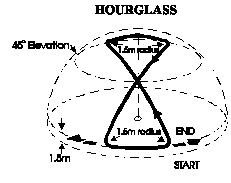 Hourglass Figure (One Required): Hourglass Figure (One Required):
The correct hourglass figure is judged when the model starts
from normal flight level and flies an hourglass course starting with an
abrupt turn followed by an inverted climb, turns into a wingover path across
the circle center for a distance equal to half the total climb, turns into
an inverted dive, and recovers at normal flight level. The flight paths
of the climb and the dive cross at 45 degrees elevation. The four rounded
corners of the figure shall have a radius of approximately 1.5 meters (4.9
feet) and the flight path forms two equilateral triangles of equal size,
turned peak to peak, and one in vertical line above the other.
Errors:
Maneuver starts at other than the normal flight level of 1.2-1.8
meters (3.9-5.9 feet). Turns are rough and wobbly or exceed a2.1 meters
(6.9 feet) radius. Top of figure is not within 0.6 meter (2 feet) of the
90 degrees position over the pilot's head. Triangle segments are not of
equal length. The maneuver is not symmetrical around the vertical line
through the crossing point at 45 degrees elevation. Recovery is not at
normal flight level of 1.2-1.8 meters (3.9-5.9 feet).
Return to STUNT PATTERN LIST
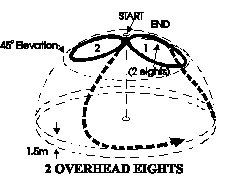 Overhead Figure Eights (Two Required): Overhead Figure Eights (Two Required):
Overhead eights are to be entered and completed at the intersection
point of the circles, directly over the flyer's head, and exited from the
same point. The inside loop must be flown first. Correct overhead eights
are judged when the model makes two eights, each consisting of two round
circles of the same size, with the intersection or point of tangency directly
over the flyer's head. The model must enter the eights with a vertical
climb through the center of the circle, and must always point in this direction
at the center of the eights. The eights must be symmetrical and the model
at the lowest point of each circle must be at a point of 45 degrees elevation.
Errors:
Model is not vertically overhead at entry. Low point of circles
is not within 0.6 meter (2 feet) of the 45 degrees elevation point. Loops
are not round and equal in size. Point of intersection varies. Second eight
is not in the same position as the first.
Return to STUNT PATTERN LIST
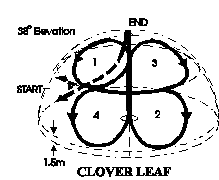 Four-leaf Clover (One Required): Four-leaf Clover (One Required):
The maneuver is entered from level flight at approximately
38 degrees elevation and consists of one full inside loop, level flight,
three-fourths of an outside loop, vertical climb, three fourths of an outside
loop, level inverted flight, three-fourths of an inside loop, and a vertical
climb. The right loops are tangent to the left loops along a vertical plane
of symmetry through the center of the clover leaf, and the bottom loops
are tangent at the top loops. The loops are of equal size and they are
connected by horizontal and vertical flight paths. The bottom points of
the maneuver shall be at the 1.5 meters (4.9 feet) height, and the top
shall be tangent to the vertical plane through the circle center. When
the last loop is performed, the maneuver is made complete by a vertical
climb through the center of the four-leaf clover. (Exit the maneuver over
the top of the circle into the wind, returning to normal level upright
flight on the other side of the circle.)
Errors:
Entry is not within 0.6 meter (2 feet) of the 38 degrees elevation
point. Loops are rough or not of equal size. Parts connecting loops are
not properly horizontal or vertical according to the maneuver sketch. Bottoms
of lower loops are not at a height between 1.2-1.8 meters (3.9-5.9 feet).
Tops of upper loops are not within 1.2 meters (3.9 feet) of the vertical
plane through the circle center. Loops are not properly tangential to form
a square pattern. Model recovers before it has flown vertically through
the clover pattern.
Return to STUNT PATTERN LIST
Landing:
A correct landing is judged when the model descends to land
with no bounce or unusual roughness, and without any part of the model
other than the landing gear having touched the ground. (In the US pattern
there is no requirement for the plane to travel any particular distance
before landing, nor is there any prescribed point at which touch down must
be made after descent starts or the engine quits.) Main wheel(s) or
three-point landings are permissible.
Errors:
An error is committed whenever the model bounces or when any
part of the model other than the landing gear touches the ground. A crash,
or a flip over, a belly or upside down landing receives no marks and would
also require forfeiture of the 25 pattern points. An error occurs each
time the model deviates from a smooth descent. Any unusual circumstances
outside the pilot's control, which may have caused one of the above mentioned
errors, will be taken into consideration by the judges. NOTE: It
is permissible to extend (by whipping) the descent, to achieve the minimum
two laps between maneuvers, to maintain eligibility for pattern points.
Return to STUNT PATTERN LIST
Flight Pattern:
Maneuvers shall be accomplished in the order listed below.
The contestant shall notify the judges prior to the flight as to (any)
specific maneuver(s) he wishes to omit in order that the judges will not
be confused as to what maneuvers to follow. At least two laps of level
flight shall precede each maneuver, including landing. (A nominal interpretation
of the two lap level flight requirement is the accepted interpretation,
allowing the starting point of one maneuver to begin slightly less than
two full laps after the exit point of the prior maneuver due to the width
of the maneuvers.) If the model enters the starting point of any maneuver
but that maneuver is not fully completed, the attempted/incomplete maneuver
shall be awarded a minimum score of 10. Each maneuver may be attempted
only once. The flight will become official when the aircraft turns into
the inverted part of the Reverse wingover. The pilot has the right to call
off the flight at any time before this maneuver by signaling the judges.
Twenty-five flight pattern points shall be awarded a contestant who
successfully completes the entire pattern as listed below.
ERRORS:
Not doing the correct number of consecutive maneuvers, doing
less that two laps between maneuvers, entering or exiting a maneuver in
any way other than is illustrated in the maneuver section, and doing an
incomplete maneuver all will result in a loss of flight pattern points.
Omitting any maneuver either intentionally or otherwise, or completing
a maneuver out of its proper order shall result in loss of flight pattern
points. A crash or failure to complete the pattern due to engine failure
shall also result in loss of flight pattern points. Exceeding the eight
minute total elapsed time limit will cause loss of points for any maneuvers
performed after the time limit, as well as loss of flight pattern points.
Return to STUNT PATTERN LIST
Final Thoughts And Observations:
Although the rule book lays down very specific descriptions
of every maneuver along with a description of what constitutes an error,
the fact remains that judging the pattern always shall remain a very subjective
thing. When an airplane is flying within the confines of a 140 foot circle
and then dives at 50 to 60 miles per hour towards the ground, only to dart
off into another direction, how many judges can truly tell whether or not
it performed within the limits of the prescribed 4-6 foot bottom, hit a
precise 45 degree intersection, or flew precisely 90 degrees overhead of
the flier? We fly against the moving background of a blue sky, making it
hard enough for the flier to guess the preciseness of the 45 degree angle,
much less the judge sitting on the outside who is looking at the maneuver
from a different perspective. Couple this with the fact that each maneuver
is described on a flat plane while we are performing it against a sphere.
Thus a "square" loop cannot truly be performed with precise 90
degree bottom corners, for then we would produce a trapezoid with the sides
pointing in towards a common point up on top. The bottom corners must,
therefore, be closer to 100 degrees and the top corners closer to 80 as
we give the "appearance" of a square maneuver to the judge on
the outside. Only the definition of the square eight concedes the fact
that the sides and bottom portions of the maneuver will be equal and the
top portions will be smaller. Couple this with the fact that it has been
proven impossible to turn a five foot corner at these speeds, we end up
giving the allusion of sharpness and let the judge score what he thinks
he sees. In the end it still proves challenging to see how close we can
come to producing the figures prescribed in the knowledge that we shall
never be perfect. No, never! Thus we have always got something to learn,
something to strive for, something to improve, something to gain, and a
reason to fly just one more pattern. Just one more...to see if we can finally
get it right! Gentlemen: Start your engines. Let the flying begin.
Return to STUNT PATTERN LIST
Back to TOP
HOME
|
 Takeoff and level flight:
Takeoff and level flight:
 Reverse Wingovers (one required):
Reverse Wingovers (one required):
 Consecutive
Inside Loops (Three Required):
Consecutive
Inside Loops (Three Required):
 Inverted Flight (two laps):
Inverted Flight (two laps):
 Consecutive Outside Loops
(Three Required):
Consecutive Outside Loops
(Three Required):
 Consecutive Inside Square Loops
(Two Required):
Consecutive Inside Square Loops
(Two Required):
 Consecutive
Outside Square Loops (Two Required):
Consecutive
Outside Square Loops (Two Required):
 Consecutive
Inside Triangular Loops (Two Required):
Consecutive
Inside Triangular Loops (Two Required):
 Horizontal
Eights (Two Required):
Horizontal
Eights (Two Required):
 Square Horizontal Eights
(Two Required):
Square Horizontal Eights
(Two Required):
 Vertical Eights (Two Required):
Vertical Eights (Two Required):
 Hourglass Figure (One Required):
Hourglass Figure (One Required):
 Overhead Figure Eights (Two Required):
Overhead Figure Eights (Two Required):
 Four-leaf Clover (One Required):
Four-leaf Clover (One Required):